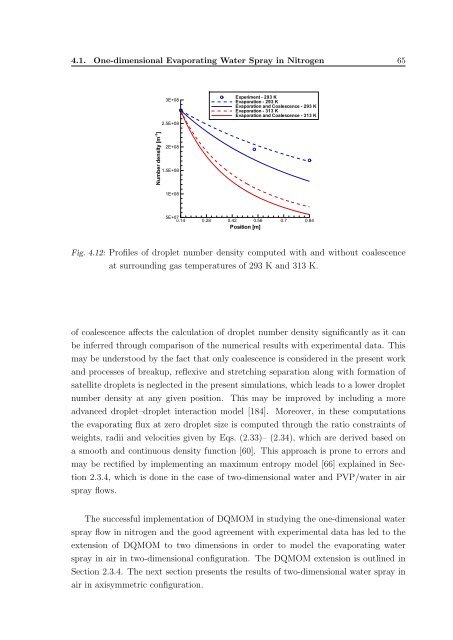INAUGURAL–DISSERTATION zur Erlangung der Doktorwürde der ...
INAUGURAL–DISSERTATION zur Erlangung der Doktorwürde der ...
INAUGURAL–DISSERTATION zur Erlangung der Doktorwürde der ...
Create successful ePaper yourself
Turn your PDF publications into a flip-book with our unique Google optimized e-Paper software.
4.1. One-dimensional Evaporating Water Spray in Nitrogen 65<br />
3E+08<br />
2.5E+08<br />
Experiment - 293 K<br />
Evaporation - 293 K<br />
Evaporation and Coalescence - 293 K<br />
Evaporation - 313 K<br />
Evaporation and Coalescence - 313 K<br />
Number density [m -3 ]<br />
2E+08<br />
1.5E+08<br />
1E+08<br />
5E+07<br />
0.14 0.28 0.42 0.56 0.7 0.84<br />
Position [m]<br />
Fig. 4.12: Profiles of droplet number density computed with and without coalescence<br />
at surrounding gas temperatures of 293 K and 313 K.<br />
of coalescence affects the calculation of droplet number density significantly as it can<br />
be inferred through comparison of the numerical results with experimental data. This<br />
may be un<strong>der</strong>stood by the fact that only coalescence is consi<strong>der</strong>ed in the present work<br />
and processes of breakup, reflexive and stretching separation along with formation of<br />
satellite droplets is neglected in the present simulations, which leads to a lower droplet<br />
number density at any given position. This may be improved by including a more<br />
advanced droplet–droplet interaction model [184]. Moreover, in these computations<br />
the evaporating flux at zero droplet size is computed through the ratio constraints of<br />
weights, radii and velocities given by Eqs. (2.33)– (2.34), which are <strong>der</strong>ived based on<br />
a smooth and continuous density function [60]. This approach is prone to errors and<br />
may be rectified by implementing an maximum entropy model [66] explained in Section<br />
2.3.4, which is done in the case of two-dimensional water and PVP/water in air<br />
spray flows.<br />
The successful implementation of DQMOM in studying the one-dimensional water<br />
spray flow in nitrogen and the good agreement with experimental data has led to the<br />
extension of DQMOM to two dimensions in or<strong>der</strong> to model the evaporating water<br />
spray in air in two-dimensional configuration. The DQMOM extension is outlined in<br />
Section 2.3.4. The next section presents the results of two-dimensional water spray in<br />
air in axisymmetric configuration.













